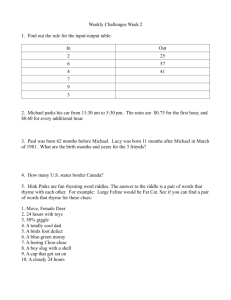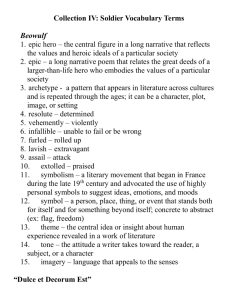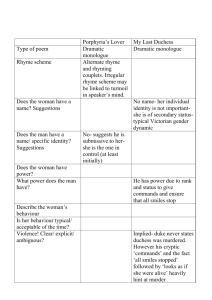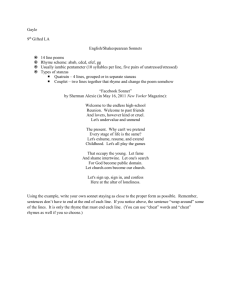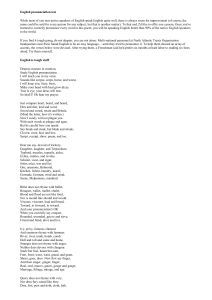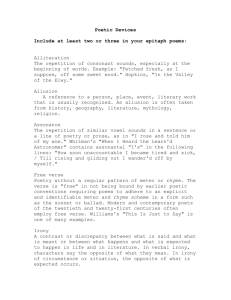alliteration: the deliberate repetition of initial consonant sounds
advertisement
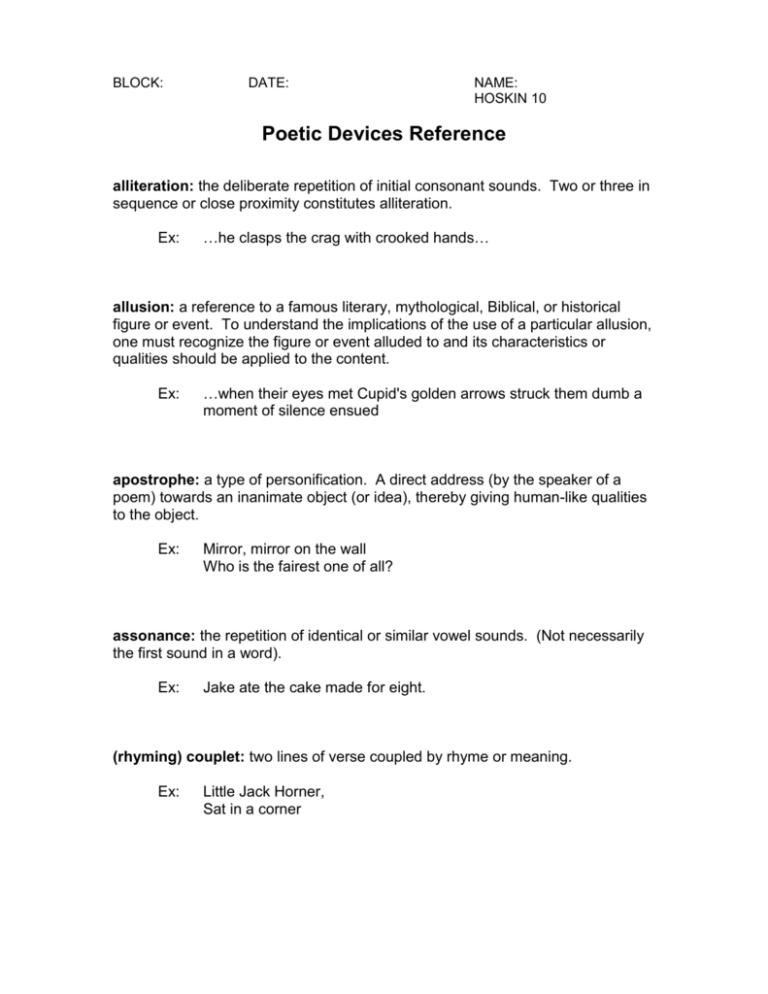
BLOCK: DATE: NAME: HOSKIN 10 Poetic Devices Reference alliteration: the deliberate repetition of initial consonant sounds. Two or three in sequence or close proximity constitutes alliteration. Ex: …he clasps the crag with crooked hands… allusion: a reference to a famous literary, mythological, Biblical, or historical figure or event. To understand the implications of the use of a particular allusion, one must recognize the figure or event alluded to and its characteristics or qualities should be applied to the content. Ex: …when their eyes met Cupid's golden arrows struck them dumb a moment of silence ensued apostrophe: a type of personification. A direct address (by the speaker of a poem) towards an inanimate object (or idea), thereby giving human-like qualities to the object. Ex: Mirror, mirror on the wall Who is the fairest one of all? assonance: the repetition of identical or similar vowel sounds. (Not necessarily the first sound in a word). Ex: Jake ate the cake made for eight. (rhyming) couplet: two lines of verse coupled by rhyme or meaning. Ex: Little Jack Horner, Sat in a corner anaphora: emphasizing words by repeating them at the beginnings of neighbouring clauses or subsequent lines of verse. Ex: I have been one acquainted with the night. I have walked out in rain -- and back in rain. I have outwalked the furthest city light. I have looked down the saddest city lane. I have passed by the watchman on his beat. enjambment: enjambment occurs when the meaning of one line is continued onto the next line (much like in regular prose). Ex: The itsy bitsy spider Went up the water spout. hyperbole: an extreme exaggeration. A figure of speech. Ex: …faster than a speeding bullet, more powerful, than a locomotive... imagery: a recurring theme in a poem expressed through repeated, rich, sensory images. imperfect rhyme: imperfect rhyme employs two words which are very close in sound, but that do not rhyme exactly. This type of rhyme maintains rhyme scheme in poems where a pattern exists. Ex: And on that cheek, and o'er that brow, So soft, so calm, yet eloquent. The smiles that win, the tints that glow, But tell of days in goodness spent. irony: sometimes irony is described as 'the last thing one would expect'. In poetry, irony is usually obvious at the end of a poem and takes the form of a surprise. The poem's tone, content, and form lead you to believe one thing, but your expectations are mocked when, at the end, something opposite is expressed/revealed. The way I see it I'm smarter than you, because I fell in love with you, And you still haven't. metaphor: a direct comparison between two different things (nouns) with similar or comparable qualities. Ex: Music is the drug I crave. onomatopoeia: words that sound like the sounds they describe. Ex: "Snap, crackle, pop," Rice Crispies! oxymoron: a figure of speech in which two words with contrasting/contradictory meanings are situated side by side for descriptive effect. Ex: "Good grief," said Charlie Brown. paradox: a figure of speech in which a phrase or sentence expresses contrasting or contradictory ideas. (A type of extended oxymoron). Ex: In seeking to live, we find we seek to die. personification: the treating of an object or an abstract thing as if it had human qualities. Ex: The veil of fog hung over the harbour. sibilance: having or making a hissing sound. Words in sequence or close proximity which contain repeated 's' or soft 'c' sounds create sibilance in poetry. Does not necessarily have to be the initial sound. Ex: "Shhh, ssssleep," the snake seemed to hiss and he slithered towards the slumbering swallows. simile: a type of metaphor in which an indirect comparison between two different things (nouns) which have similar or comparable qualities is made. Similes always contain 'like,' 'as,' or 'than' in their comparisons. Ex: Your absence has gone through me like thread through a needle. visual rhyme: visual rhyme employs two words which appear to rhyme, but when pronounced aloud, do not rhyme. (Rather, they are usually close sounding). Visual rhymes rhyme to the eyes, not the ears. Ex: In a way, I have only one thing to prove, Dear, it's one thing to say, but another to love. zeugma: a figure of speech in which one word (a verb) is made to refer to two or more words (objects of the verb), but has to be understood differently in the two different contexts. In one case, the verb flexes literally onto one object, and metaphorically onto the other. Ex: He kindled my spirits and the fire. ________________________________________________________________ ________________________________________________________________ ________________________________________________________________ ________________________________________________________________ ________________________________________________________________


